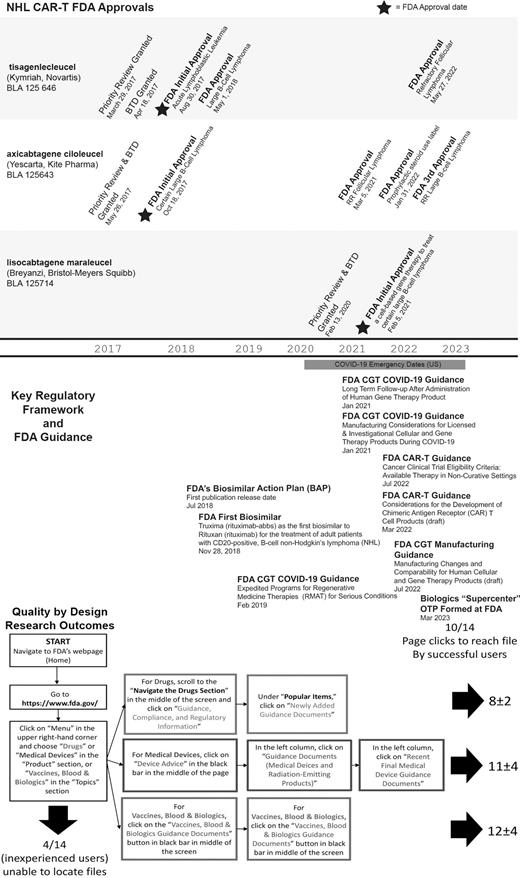Background: Non-Hodgkin lymphoma (NHL) remains a challenging hematological disease due to varied presentation and etiologies. Historically, cell/gene therapy guidance from the U.S. Food and Drug Administration (FDA) have partial utility in CAR-T development owing to the unique nature of cell-based gene modification but overlap with some key regulatory tenants of broader gene therapy. Inability to identify and apply appropriate guidance poses a challenge for next generation CAR-T immuno- and targeted therapy developers and start-ups, who are situated in a uniquely dynamic regulatory compliance landscape.
Methods: A pragmatic Quality by Design (QbD) approach was taken to analyzing the usability and utility of publicly available web-based regulatory guidance via ethnographic observation of an asynchronous industry focus groups ( N = 14) of quality and translational research professionals seeking NHL regulatory guidance and/or regulatory approval information relevant to development of new CAR-T therapeutics (Fig. 1, top) over the course of approximately 10 minutes per observation. Further, a database of innovator and generic approval timelines was created for the 93 currently FDA-approved therapies based on ease of finding corresponding information.
Results: Within the focus group, 7% (1/14) rated their team's confidence high in differences between recent specific FDA guidance for early phase CAR-T (Mar 2022) and prior gene and cell therapy guidance agnostic to gene therapy vs CAR-T and 79% (11/14) felt additional CAR-T manufacturing change guidance was needed. QbD stepwise analysis showed experienced users ( N = 9) clicked 10±3 pages before arriving at a desired FDA web-based guidance from the relevant framework (Fig. 1, bottom); remaining inexperienced users were unable to locate the guidance within the test period, primarily due to discrepancies in identifying appropriate classification and center (i.e. FDA CDER/CDER/CDRH) to locate the target guidance. Users had more difficulty locating information on biosimilars and generic drugs, owing in part to confusion between generic terminology on drug vs biologics/vaccines web portals.
Conclusions: While current guidance has improved clarity of translational development, additional clarity and ease of access is needed for guidance on manufacturing change and implementation at non-traditional GMP sites for CAR-T to further streamline and scale these therapies. Further, generics developers, in particularly in biosimilars, may face larger hurdles in locating and applying appropriate regulatory guidance using current web-based resources. The research provides a foundation for developing merging web-based aggregation systems to improve the accessibility of regulatory content, utility, and usability of publicly available regulatory information. Such systems have the potential to improve time-to-market for innovator therapeutics and cost-effective biosimilars in NHL. This research provides insight into future web systems and natural language processing (NLP) design that could utilize merging automation to make regulatory information more accessible within key areas.
Disclosures
Johnson:Cytiva: Current Employment. Wang:Cytiva: Current Employment. Boucher:Cytiva: Current Employment. Fulgoni:Cytiva: Current Employment.


